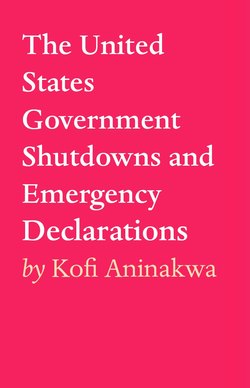The United States Government Shutdowns and Emergency Declarations

Реклама. ООО «ЛитРес», ИНН: 7719571260.
Оглавление
Kofi Aninakwa. The United States Government Shutdowns and Emergency Declarations
Acknowledgements
Dedication
Preface
Chapter One – What is a shutdown and causes?
General Short-term impact on spending
Chapter Two – The Southern Border Wall Shutdown. 22nd December 2018 – January, 25th 2019
How will federal workers be affected?
What won’t be affected?
Chapter Three – Why the Government Shutdown May Cost Tens of Billions
Information on the Impact of a Government Shutdown
Medicare, Medicaid, Social Security:
Federal Workers:
US military:
National Parks and Museums:
Science
Travel/Visas
Courts/Law Enforcement
Homeland Security
Veterans Services
Small Businesses
Home Loans
Student Loans
Taxes
How the last government shutdown ended
Chapter Four – List of the previous partial or complete shutdowns from 1976. 2018 January 19th to 23rd: 3 days
2018 February: 1 day
2013: Tuesday, October 1st to 16th, 2013: 16 days
1995-1996 December 16, 1995 to January 6: 21 days
Shutdown #17: Clinton v. Gingrich, the Second: Baseline Boogaloo
Chapter Five. 1995 November 13th -19th: 5 days
Shutdown #16: Clinton v. Gingrich, the First
1990 October 5th -9th: 3 days
Shutdown #15: Somebody come up with a plan!
1987 December 18th -20th: 1 day
Shutdown #14: I Think You're a Contra
1986 October 16 to 18: 1 day
Shutdown #13: Welfare expansions fail
Chapter Six. 1984 October: 3rd-5th - 1 day
Shutdown #12: Omni shutdown II — Shut Down Harder
Shutdown #11: Omni shutdown
1983 Thursday, Nov. 10 to Monday, Nov. 14, 1983: 3 days
Shutdown #10: So you can have your missiles but Israel gets some, too
1982 December, 17th to 21st, 3 days
Shutdown #9: Tip O'Neill takes on a nuclear missile and wins
Chapter Seven. 1982 September 30 to October 2, 1 day
Shutdown #8: Let them eat shutdown
1981 November 20th to 23rd: 2 days
Shutdown #7: You wouldn't like Reagan when he's angry
1979 September 30-October: 11 days
Shutdown #6: Higher pay, fewer abortions
1978 September 30-October 18: 18 days
Shutdown # 5:
Chapter Eight. 1977 November-30th to December 9th: 8 days
Shutdown #4: The Abortion Shutdown III: Dark of the Moon
1977 October-November: 8 days. Shutdown #3: The Abortion Shutdown II: Abortion Boogaloo
The Abortion Shutdown
1977 September-30 to October 13: 12 days. Shutdown #2: The Abortion Shutdown
1976 September 30-October 11: 10 days
Shutdown #1: HEWdown
Chapter Nine. The Actual National effects of the Partial Shutdown Ending in January 2019 from The Congressional Budget Office (CBO) Summary
Background
Effects on the Federal Budget
Spending
Employees’ Compensation
Spending on Goods and Services
Revenues and Collections
Macroeconomic Effects
Effects on Real GDP
Federal Employees’ Hours and Compensation
Spending on Goods and Services
Effects on Aggregate Demand
Effects on the Labor Market
Distributional Effects
Methods and Uncertainty
Other Possible Effects of the Partial Shutdown
Measures that can be adopted to avoid costly government shutdowns
Chapter Ten – The National Emergency Declarations
TRUMP'S STATES OF EMERGENCY
Here is a list of the national emergencies declared and which are still ongoing. Nov 14, 1979:
Nov 14, 1994:
Jan. 2, 1995:
March 15, 1995:
October 21, 1995:
March 1, 1996:
November 3, 1997:
June 26, 2001:
Aug 17, 2001:
Sept 14, 2001:
Sept 23, 2001:
March 6, 2003:
May 22, 2003:
May 11, 2004:
June 16, 2006:
Oct 27, 2006:
Aug 1, 2007:
June 26, 2008:
April 12, 2010:
February 25, 2011:
July 25, 2011:
May 16, 2012:
March 16, 2014:
April 3, 2014:
May 12, 2014:
March 8, 2015:
April 1, 2015:
Nov 23, 2015:
Dec 20, 2017:
Sept 12, 2018:
Nov 27, 2018:
February 15, 2019
Chapter Eleven
President Jimmy Carter
President Ronald Reagan
President George H.W. Bush
President Bill Clinton
President George W. Bush
President Barack Obama
President Donald Trump
The president declared his emergency on the following premises: Humanitarian and security crisis
Driving down jobs and wages
ICE arrests
Illegal drugs
Wall paid for by Mexico
Some Advantages of National Emergency Declaration
Some Disadvantages of National Emergency Declaration
Sources
Отрывок из книги
I dedicate this book to God Almighty my creator, my strong pillar, my source of inspiration, wisdom, knowledge and understanding. He has been the source of my strength throughout this program and on His wings only have I soared.
I dedicate this book to all the Federal workers in the United States and abroad who irregularly face the blunt of administrative impasses which frequently leads to shutdowns from 1976 and those to come.
.....
The December 22nd, 2018, shutdown is the 21st government shutdown since Congress adopted new budgeting procedures in 1976, according to the Congressional Research Service, and it's also the third this year alone. For perspective, there were only three shutdowns in the 25 years before 2018, lasting from one day to 10 days. The last shutdown was in 2018-2019 and lasted for grueling 35 days. The partial government shutdown that started Saturday, 22, 2018 stretched through to Friday January 25th 2019. It has now become one of the longest, the worst and grueling ever. The history of government gridlock shows the same pattern: Shutdowns are usually resolved in just a few days, or they drag on for two or three weeks. The Standard & Poor's (S & P) in 2018’s estimated that the shutdowns cost the U.S. $6.5 billion a week. The last major shutdown, in 2013, cost $24 billion - a rate of nearly $1.5 billion a day, according to Standards and Poor.
This repayment, essentially increasing the size of their first post-shutdown paychecks, had significant and immediate effects on household spending. Sudden spikes in spending occurred in the days after the paychecks were disbursed, largely erasing some of the most dramatic declines in spending during the previous two weeks.
.....